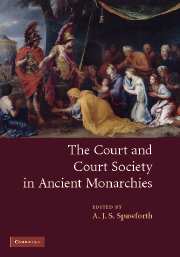Book contents
- Frontmatter
- Contents
- List of figures
- List of tables
- Notes on contributors
- Acknowledgements
- List of abbreviations
- Introduction
- 1 New out of old? Court and court ceremonies in Achaemenid Persia
- 2 King, court and royal representation in the Sasanian empire
- 3 The court of Alexander the Great between Europe and Asia
- 4 Friends in high places: the creation of the court of the Roman emperor
- 5 The imperial court of the late Roman empire, C. AD 300–C. AD 450
- 6 The imperial court in Han China
- 7 Court and palace in ancient Egypt: the Amarna period and later Eighteenth Dynasty
- Bibliography
- Index
7 - Court and palace in ancient Egypt: the Amarna period and later Eighteenth Dynasty
Published online by Cambridge University Press: 22 September 2009
- Frontmatter
- Contents
- List of figures
- List of tables
- Notes on contributors
- Acknowledgements
- List of abbreviations
- Introduction
- 1 New out of old? Court and court ceremonies in Achaemenid Persia
- 2 King, court and royal representation in the Sasanian empire
- 3 The court of Alexander the Great between Europe and Asia
- 4 Friends in high places: the creation of the court of the Roman emperor
- 5 The imperial court of the late Roman empire, C. AD 300–C. AD 450
- 6 The imperial court in Han China
- 7 Court and palace in ancient Egypt: the Amarna period and later Eighteenth Dynasty
- Bibliography
- Index
Summary
I shall make Akhetaten for the Aten, my father, in this place … Nor shall the Great King's wife say to me ‘Look, there is a nice place for Akhetaten in another place’, nor shall I listen to her. Nor shall any official in my presence – whether officials ‘of favour’ or officials ‘of the outside’, or the chamberlains, or any people who are in the entire land – say to me: ‘Look there is a nice place for Akhetaten in another place’, nor shall I listen to them.
Oath of Akhenaten (Murnane and van Siclen 1993: 40)Around 1347 BC, King Akhenaten stated under oath his intention of founding a new city as his residence and cult centre for the visible sun-disk or Aten, whom he had recently promoted to the position of sole god, excluding the majority of the traditional Egyptian pantheon. Details of the foundation and reaffirmation ceremonies were carved onto boundary stelae cut into the cliffs around the site and these are amongst the most important historical documents for the period (Murnane and van Siclen 1993). The above statement emphasises the king's resolve to stand by his chosen site for the city. In passing, he makes an unusual acknowledgement of the potential influence of royal women and courtiers.
Official royal texts in Egypt rarely mention individuals other than the king.
- Type
- Chapter
- Information
- The Court and Court Society in Ancient Monarchies , pp. 267 - 328Publisher: Cambridge University PressPrint publication year: 2007
- 2
- Cited by



